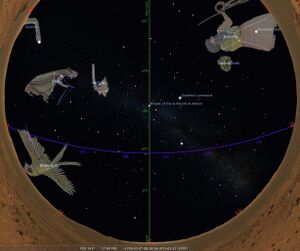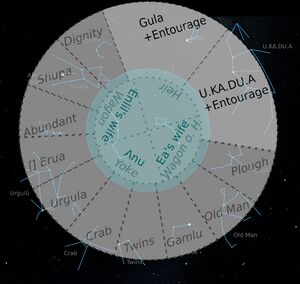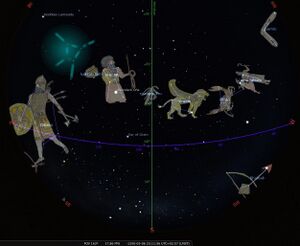DINGIR.GUB.BA: Difference between revisions
No edit summary |
DavidHilder (talk | contribs) No edit summary |
||
| (4 intermediate revisions by 2 users not shown) | |||
| Line 21: | Line 21: | ||
* b) <sup><mul></sup>an.gub.ba.meš ḫi-pí eš-šú = <sup>d</sup>sîn(30) u <sup>d</sup>Šamaš(utu) [SpTU III, 116 Rs. iii 20]. |
* b) <sup><mul></sup>an.gub.ba.meš ḫi-pí eš-šú = <sup>d</sup>sîn(30) u <sup>d</sup>Šamaš(utu) [SpTU III, 116 Rs. iii 20]. |
||
| ⚫ | |||
|Example |
|||
|- |
|- |
||
|Text BM 77054. |
|'''Text BM 77054.''' |
||
* ina <sup>iti</sup>ab ud.15.kam <sup>mul</sup><dingir>.gub.ba<sup><meš></sup> ina r[a-be<sub>2</sub>-e...] / <sup>mul</sup>ši-nu-nu-tum [...] "15th tebetu Standing Gods in[os] / Swallow [...]" [George 1991, 304-305, r. 9′-10′]. |
* ina <sup>iti</sup>ab ud.15.kam <sup>mul</sup><dingir>.gub.ba<sup><meš></sup> ina r[a-be<sub>2</sub>-e...] / <sup>mul</sup>ši-nu-nu-tum [...] "15th tebetu Standing Gods in[os] / Swallow [...]" [George 1991, 304-305, r. 9′-10′]. |
||
| |
| |
||
|- |
|- |
||
|'''MUL.APIN.''' |
|'''MUL.APIN.''' |
||
* (1) The stars of Enlil (no. 21): |
|||
* (1) The stars of Enlil (no. 21): <sup>mul</sup>DINGIR.GUB.BA<sup>meš</sup> šu-ut E<sub>2</sub>-kur "Standing Gods from Ekur" (I i 23), for a parallel see. [Horowitz 1989-90, 116, BM 54817:10']. |
|||
** <sup>mul</sup>DINGIR.GUB.BA<sup>meš</sup> šu-ut E<sub>2</sub>-kur |
|||
| ⚫ | |||
** "Standing Gods of the Ekur" (I i 23), |
|||
| ⚫ | |||
** for a parallel see. [Horowitz 1989-90, 116, BM 54817:10']. |
|||
| ⚫ | * |
||
|[[File:EkurGodsSchema on stellarium txt.jpg|thumb|The constellations of "The Ekur" in Stellarium and a schema overlay: The Sitting Gods are bluish, and the Standing Gods are darker gray. The two additional Non-Ekur divine "entities" with their entourage (Susanne M Hoffmann 2025).]] |
|||
|Example |
|||
|- |
|- |
||
|'''MUL.APIN.''' |
|||
| ⚫ | |||
| ⚫ | |||
* <sup>mul</sup> |
** a) <sup>mul</sup>PAN u <sup>mul</sup>LUGAL KUR<sup>me mul</sup>UZ<sub>3</sub> ŠU<sub>2</sub>-bi |
||
** "The Bow and the King rises, the Goat sets" (I iii 19), |
|||
** b) <sup>mul</sup>Pa-bil-sag <sup>mul</sup>Za-ba<sub>4</sub>-ba<sub>4</sub> u DINGIR. GUB.BA<sup>meš</sup>-ma / <sup>mul</sup>KAK.SI.SA<sub>2</sub> <sup>mul</sup>PAN u <sup>mul</sup>GAM<sub>3</sub> ŠU<sub>2</sub><sup>meš</sup> |
|||
** "Pabilsag, Zababa and the Staff rise, the Arrow, Bow and thee Staff goes down" (I iii 27-28). |
|||
see also (Kurtik b06) [[PAN]]. |
|||
|[[File:StandGods MUL.APIN-Iiii27stellarium.jpg|alt=Stellarium map|thumb|The Standing Gods in MUL.APIN I iii 27. ]] |
|||
|- |
|||
|'''MUL.APIN.''' |
|||
* (3) List of ziqpu stars: |
|||
| ⚫ | |||
|This text could be corrupted as there is actually no space between <sup>mul</sup>BAL.TEŠ<sub>2</sub>.A and <sup>mul</sup>UR.GI<sub>7</sub> where the constellation could be placed. We assume that the scribe in this case accidentally copied the rubric marker from MUL.APIN (1) to here so that it imposes a constellation. |
|||
|- |
|||
|'''MUL.APIN.''' |
|||
* (4) Culminations and simultaneous heliacal risings: |
|||
| ⚫ | |||
** "The 15th of Tebet, the Standing Gods in the middle of heaven against your chest, and the Swallow rises" (I iv 28) [MA, 25, 51, 58, 66]. |
|||
|[[File:Swallow MULAPIN Iiv28 stellarium.jpg|alt=Stellarium map|thumb|The Swallow of the MUL.APIN uranology just risen: no one of the Standing Gods of the first list is in the middle of the sky during its rising, so the meaning of the term in this case has completely changed. It is even the opposite of what it indicated before (map with Stellarium; Susanne M Hoffmann 2025). ]] |
|||
|- |
|||
| ⚫ | |||
* <sup>mul</sup>dingir.gub.ba<sup>meš</sup> = <sup>d</sup>30 u <sup>d</sup>utu |
|||
* "Standing Gods = Sin and Shamash" [Mesop.Astrol., App. B:154]. |
|||
| |
| |
||
|- |
|- |
||
|List of stars VR 46, 1:15. |
|'''List of stars VR 46, 1:15.''' |
||
* <sup>mul</sup><dingir>.gub.ba<sup>meš</sup> šu-ut E<sub>2</sub>-kur = <sup>d</sup>30 u <sup>d</sup>u.gur |
|||
* |
* "Standing (Gods) from Ekur = Sîn and Nergal". [HBA, 51:15; Wee 2016, 162-3:15]. |
||
| |
| |
||
|} |
|} |
||
===Additional=== |
===Additional=== |
||
'''II. Deity.''' |
|||
==== II. Deity. ==== |
|||
"Standing deities" (among epithets: ilū ṣīrūtu "High gods") are known both from lists of gods and from other texts. Worshiped as protectors, guardians of temples; mentioned as a pair with [[DINGIR.KU.A|DINGIR.KU.A<sup>meš</sup>]] "Sitting deities". [AHw, 51; CAD A/2, 117-118; Heimpel 1968, 323; Sidersky 1920, 567:16]. A special group was an.gub.ba<sup>meš</sup> ša<sub>2</sub> e<sub>2</sub>-kur "Standing gods from Ekur", which apparently had astral significance. In the AN: <sup>d</sup>Anum series (I 364-366) they are defined as: <sup>d</sup>UL.maš / <sup>d</sup>AŠ.daḫ / 2 dingir.gub.ba e<sub>2</sub>.kur.ra.ke<sub>4</sub> "Ulmash, AŠ.daḫ = 2 standing deities from Ekur". [CT 24, 24:67-68; Litke 1998, 65]. For other versions of the identification of the "Standing gods" see. [CAD A/2, 117-118; Tallqvist 1938, 25]. |
"Standing deities" (among epithets: ilū ṣīrūtu "High gods") are known both from lists of gods and from other texts. Worshiped as protectors, guardians of temples; mentioned as a pair with [[DINGIR.KU.A|DINGIR.KU.A<sup>meš</sup>]] "Sitting deities". [AHw, 51; CAD A/2, 117-118; Heimpel 1968, 323; Sidersky 1920, 567:16]. A special group was an.gub.ba<sup>meš</sup> ša<sub>2</sub> e<sub>2</sub>-kur "Standing gods from Ekur", which apparently had astral significance. In the AN: <sup>d</sup>Anum series (I 364-366) they are defined as: <sup>d</sup>UL.maš / <sup>d</sup>AŠ.daḫ / 2 dingir.gub.ba e<sub>2</sub>.kur.ra.ke<sub>4</sub> "Ulmash, AŠ.daḫ = 2 standing deities from Ekur". [CT 24, 24:67-68; Litke 1998, 65]. For other versions of the identification of the "Standing gods" see. [CAD A/2, 117-118; Tallqvist 1938, 25]. |
||
==== III. Symbol. ==== |
|||
Description in VAT 9428 r. 12: 3 MUL.MEŠ n[a-bu-ti <sup>mul</sup>A]N.GUB.BA<sup>meš</sup> "3 bl[essed] stars, Standing [G]ods" [Weidner 1927, 75-76; Beaulieu et al, 2018, 23, 25, 32, Section IX, i 12]. |
Description in VAT 9428 r. 12: 3 MUL.MEŠ n[a-bu-ti <sup>mul</sup>A]N.GUB.BA<sup>meš</sup> "3 bl[essed] stars, Standing [G]ods" [Weidner 1927, 75-76; Beaulieu et al, 2018, 23, 25, 32, Section IX, i 12]. |
||
==== IV. Identification. ==== |
|||
= α, β Ophiuchi to approximately α Herculis [Weidner 1927, 84; 3 Erg. 333-334; G. 22]; |
= α, β Ophiuchi to approximately α Herculis [Weidner 1927, 84; 3 Erg. 333-334; G. 22]; |
||
| Line 66: | Line 83: | ||
==Historical Dictionaries== |
==Historical Dictionaries== |
||
{| class="wikitable" |
{| class="wikitable" |
||
| ⚫ | |||
|- |
|- |
||
!Kurtik (2022)!!Gössmann (1950) |
!Kurtik (2022, d10)!!Gössmann (1950) |
||
|- |
|- |
||
|вар. чтения: <sup>mul</sup>AN.GUB.BA.MEŠ; = angubbû «Стоящие Боги» [BPO 2, 11; G. 22; Beaulieu et al. 2018, 32]; созвездие в Геркулесе (Hercules), см. также [AHw, 51; CAD A/2, 117–118]. |
|вар. чтения: <sup>mul</sup>AN.GUB.BA.MEŠ; = angubbû «Стоящие Боги» [BPO 2, 11; G. 22; Beaulieu et al. 2018, 32]; созвездие в Геркулесе (Hercules), см. также [AHw, 51; CAD A/2, 117–118]. |
||
Latest revision as of 09:05, 31 March 2025
mulDINGIR.GUB.BAmeš is an ancient Mesopotamian asterism or a group of asterisms.
Dictionary
Variant readings: mulAN.GUB.BA.MEŠ; = angubbû "Standing Gods" [BPO 2, 11; G. 22; Beaulieu et al. 2018, 32].
Krebernik (2023)
mulDIĜIR.GUB.BAmeš & mulDIĜIR.TUŠ.Ameš. The sumerograms are ambiguous, since the first sign can be read as DIĜIR “god” or AN “heaven”, and TUŠ can also be read DÚR (both meaning “to sit”) or KU. However, the addition of A makes the reading TUŠ virtually certain. In the same manner, BA confirms the reading of GUB.BA. The Sum. forms mean “seated, sitting” and “standing”, respectively.
The corresponding entries in the dictionaries are angubbû (AHw, CAD) and ankurû (CAD), antušû (AHw), respectively. The first sumerogram, which is much more common than the second, designates a type of priest and describes the function of certain (minor) deities in god lists. In the OB Ištar ritual from Mari, the DIĜIRmeš DIĜIR-gub-bu-ú are obviously (representations of) deities, who “sit down to the left of Ištar together with (the god) Latarak” (ii 1’-3’, see Ziegler 1997, 58). The usage in MUL.APIN, where the two expressions are connected with Enlil’s temple Ekur in Nippur (“The stars of the Standing/Sitting Gods of the Ekur”) seems to be comparable. In 5R 46: 15–16., the “Standing Gods of the Ekur” are interpreted as “Sîn and Nergal”, and the “Sitting Gods” as “Anu and Enlil”, which is not applicable to MUL.APIN. The same is true of [M]UL.DIĜIR.GUB].BAmeš DIĜIR.TUŠ.Ameš in Hg, where they are identified with Sîn and Šamaš (MSL 11, 41: 52). MUL.DIĜIR.GUB.BAmeš šu-ut É.KUR / MUL.DIĜIR.TUŠ.Ameš šu-ut É.KUR (after EN 21).
Kurtik with Hilder, Hoffmann, Horowitz, Kim
Constellation in Hercules, see also [AHw, 51; CAD A/2, 117-118].
| Sources | Identifications |
|---|---|
| Lexical texts.
Series Ḫg. B VI:
|
|
Text BM 77054.
|
|
MUL.APIN.
|
|
MUL.APIN.
see also (Kurtik b06) PAN. |
|
MUL.APIN.
|
This text could be corrupted as there is actually no space between mulBAL.TEŠ2.A and mulUR.GI7 where the constellation could be placed. We assume that the scribe in this case accidentally copied the rubric marker from MUL.APIN (1) to here so that it imposes a constellation. |
MUL.APIN.
|
 The Swallow of the MUL.APIN uranology just risen: no one of the Standing Gods of the first list is in the middle of the sky during its rising, so the meaning of the term in this case has completely changed. It is even the opposite of what it indicated before (map with Stellarium; Susanne M Hoffmann 2025). |
"The Great Star List and Miscellenia."
|
|
List of stars VR 46, 1:15.
|
Additional
II. Deity.
"Standing deities" (among epithets: ilū ṣīrūtu "High gods") are known both from lists of gods and from other texts. Worshiped as protectors, guardians of temples; mentioned as a pair with DINGIR.KU.Ameš "Sitting deities". [AHw, 51; CAD A/2, 117-118; Heimpel 1968, 323; Sidersky 1920, 567:16]. A special group was an.gub.bameš ša2 e2-kur "Standing gods from Ekur", which apparently had astral significance. In the AN: dAnum series (I 364-366) they are defined as: dUL.maš / dAŠ.daḫ / 2 dingir.gub.ba e2.kur.ra.ke4 "Ulmash, AŠ.daḫ = 2 standing deities from Ekur". [CT 24, 24:67-68; Litke 1998, 65]. For other versions of the identification of the "Standing gods" see. [CAD A/2, 117-118; Tallqvist 1938, 25].
III. Symbol.
Description in VAT 9428 r. 12: 3 MUL.MEŠ n[a-bu-ti mulA]N.GUB.BAmeš "3 bl[essed] stars, Standing [G]ods" [Weidner 1927, 75-76; Beaulieu et al, 2018, 23, 25, 32, Section IX, i 12].
IV. Identification.
= α, β Ophiuchi to approximately α Herculis [Weidner 1927, 84; 3 Erg. 333-334; G. 22];
= probably α Herculis and α + β Ophiuchi [Weidner 1957-59, 78];
= ζ and η Herculis (?) [MA, 138; ASM, 278].
= part of Hercules [Mesop.Astrol., 208, App. C].
Historical Dictionaries
| Kurtik (2022, d10) | Gössmann (1950) |
|---|---|
| вар. чтения: mulAN.GUB.BA.MEŠ; = angubbû «Стоящие Боги» [BPO 2, 11; G. 22; Beaulieu et al. 2018, 32]; созвездие в Геркулесе (Hercules), см. также [AHw, 51; CAD A/2, 117–118].
I. Источники. Лексич. тексты. Cерия Ḫg. B VI: a) m[ulan.gub].bameš<u mul>an.tuš.ameš = dsin u dutu = mul-te-šir SAL.LA [MSL XI, 41:52], b) <mul>an.gub.ba.meš ḫi-pí eš-šú = dsîn(30) u dŠamaš(utu) [SpTU III, 116 Rs. iii 20]. Текст BM 77054. ina itiab ud.15.kam mul<dingir>.gub.ba.<meš> ina r[a-be2-e…] / mulši-nu-nu-tum […] «15-го тебету Стоящие Боги в[осходят…] / Ласточка […]» [George 1991, 304–305, r. 9′–10′]. MUL.APIN. (1) Звезды Энлиля (№ 21): mulDINGIR.GUB.BAmeš šu-ut E2-kur «Стоящие Боги из Экура» (I i 23), параллель см. [Horowitz 1989–90, 116, BM 54817:10']. (2) Одновременные суточные восходы и заходы: (I iii 27), см. b06BAN. (3) Список ziqpu-звезд: mulDINGIR.GUB.BAmeš на третьем месте после mulBAL.TEŠ2.A перед mulUR.GI7 (I iv 4). (4) Кульминации и одновременные гелиакические восходы: ina itiAB UD 15 KAM mulDINGIR.GUB.BAmeš MIN(=ina MURUB4 AN-e) / IGI-it GABA-ka GUBmeš mulSIM.MAḪ KUR-ḫa «15-го тебету Стоящие Боги в середине неба напротив твоей груди стоят, и Ласточка восходит» (I iv 28) [MA, 25, 51, 58, 66]. «Большой список звезд». muldingir.gub.ba.meš = d30 u dutu «Стоящие Боги = Син и Шамаш» [Mesop.Astrol., App. B:154]. Список звезд VR 46, 1:15. mul<dingir>.gub.bameš šu-ut E2-kur = d30 u du.gur «Стоящие (Боги) из Экура = Син и Нергал» [HBA, 51:15; Wee 2016, 162–3:15]. II. Божество. «Стоящие божества» (среди эпитетов: ilū ṣīrūtu «Высокие боги») известны как из списков богов, так и из других текстов. Почитались как защитники, охранители храмов; упоминаются в паре с DINGIR.KU.Ameš «Сидящими божествами» [AHw, 51; CAD A/2, 117–118; Heimpel 1968, 323; Sidersky 1920, 567:16]. Особую группу составляли an.gub.bameš ša2 e2-kur «Стоящие боги из Экура», имевшие, по-видимому астральное значение. В серии AN:dAnum (I 364–366) они определяются как: dUL.maš / dAŠ.daḫ / 2 dingir.gub.ba e2.kur.ra.ke4 «Ульмаш, AŠ.daḫ = 2 стоящих божества из Экура» [CT 24, 24:67–68; Litke 1998, 65]. Другие варианты отождествления «Стоящих богов» см. [CAD A/2, 117–118; Tallqvist 1938, 25]. III. Символ. Описание в VAT 9428 r. 12: 3 MUL.MEŠ n[a-bu-ti mulA]N.GUB.BAmeš «3 бл[естящие] звезды, Стоящие [Б]оги» [Weidner 1927, 75–76; Beaulieu et al, 2018, 23, 25, 32, Section IX, i 12]. IV. Отождествление. = α, β Ophiuchi до приблизительно α Herculis [Weidner 1927, 84; 3 Erg. 333–334; G. 22]; = вероятно, α Herculis и α + β Ophiuchi [Weidner 1957–59, 78]; = ζ и η Herculis (?) [MA, 138; ASM, 278]. = часть Геркулеса (Hercules) [Mesop.Astrol., 208, App. C]. |
Example |

